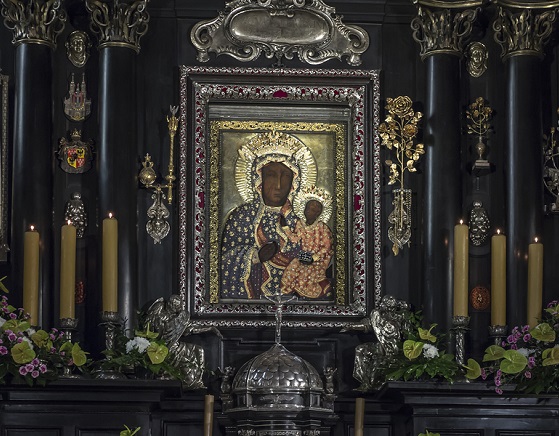The Tale of the Two Black Madonnas.

{source}
The person of Mary Magdalene plays itself powerfully on the minds of nearly anyone who has plunged into the study of the myth, the legend and the possible hidden stories of this fascinating archetype of the Divine Feminine.
In many ways, exploring Mary Magdalene is nothing short of a detective work: the search for truth between the legend, the fact, and the obfuscated stories.
One cannot even begin this search without considering the contribution of Margaret Starbird and her now famous book Woman with the Alabaster Jar.
In her book, Starbird boldly started with the idea that Mary Magdalene was the wedded wife of Jesus and had a little girl (called Sarah in one tradition and Tamar in another) with him, and that after Jesus’ crucifixion Mary went first to Alexandria and then moved to Southern France.
Through the study of art, mythology and medieval literature, Starbird traced the worship of Mary Magdalene as the mother of Jesus’ child, a belief prevalent in parts of Southern France (around Sainte-Baume), including the movement of the Cathars (so-called heretics) who were killed off in the Albigensian crusade of the mid-13th century.
After the fall of the Cathars, mysterious Black Madonnas began appearing all over Europe, then later in the rest of the world. According to Starbird and many alternative scholars who followed her ideas, these Black Madonnas represented a shadow Madonna, that is, Mary Magdalene and her child.
This idea has been developed further by Michael Baigent, Richard Leigh and Henry Lincoln in their book The Holy Blood and the Holy Grail. They claim that Mary Magdalene and her child were connected to the beginning of the first French royal dynasty, the Merovingians (countless books have been written about this idea, which has a great following among alternative researchers and adventurers).
To test their theories, I decided to explore two now-famous portrayals of the Dark Madonna, since she is considered in alternative circles as the shadow Madonna, or the real Madonna and Jesus’ wife, in this particular tradition (ideas with which I admittedly sympathize but do not always agree).
One portrayal is that of the sculpture of the Black Madonna of Chartres and the other is of the Black Madonna of Czestochowa.
The Black Madonna of Chartres in France is the first I would like to discuss because she is probably the most well-known (although definitely not the only) Black Madonna in Western Europe. When I decided to research her, I did not know I would be stepping into a minefield of controversy.
Like many stunningly beautiful Gothic cathedrals, the building of the cathedral in Chartres began at the end of the 12th century and ended in the 13th century — the building was finished around 1225 AD. Around the same time, a wooden sculpture of a Madonna was brought to a church known as the Notre Dame de Pilar.
Nothing is known of the original appearance of the Madonna (including her skin color) because in 1508 this sculpture was replaced by a replica. Throughout the centuries, however, the Madonna was remembered as black.
Indeed, many books have been written about the Black Madonna of Chartres, including perhaps the most knowledgeable and well-researched by Jean Markale, Cathedral of the Black Madonna: the Druids and the Mysteries of Chartres, in which Markale argues that the Black Madonna of Chartres relates to the Celtic black goddess Sulevia, on whose temple the cathedral had been built.
So when in 2012 a controversial renovation of the Madonna was commissioned to clean the smoke and oil which had accumulated over 500 years on the statue, many were surprised when the restored statue turned out to be white. The renovators claim that it is the statue’s original color.
This created great outrage at the time among many art critics, including the New York Times’ Martin Filler, as well as among both traditional Catholic and New Age pilgrims.
Notwithstanding this controversy, which can only be solved by testimony from a 13th-century witness (and thus is an impossible feat), many forget that in Chartres there is another statue of the Black Madonna, mostly unnoticed, known as Notre Dame de Sous Terre. This statue is also a replica of an older version of itself that was burned in 1789 during the French Revolution
This second Black Madonna — Notre Dame de Sous Terre — translates from the French as The Madonna of the Underground or from Underground. The statue is made of dark wood. It is not known whether the artist intended to portray her as the shadow Madonna (and thus Mary Magdalene) or it wast just a choice of wood or any other reason.
In the modest opinion of this spiritual detective, Madonna sounds much more like the Madonna of Starbird’s theory: Mary Magdalene as the mother of Jesus’ child, a shadow Madonna or a Madonna in hiding.
The second Black Madonna that I would like to discuss here in reference to Starbird’s theory is the Black Madonna of Czestochowa in Poland.
It is a little-known fact that the painting of the Black Madonna of Czestochowa has for centuries been the most worshiped holy image in Poland, and she is actually the deity most worshiped by Polish Catholics. She is even referred to as the Queen of Poland or Our Lady of Czestochowa.
Quite a bit is known about the painting itself. It certainly represents the Black Madonna, as it was painted in the Byzantine Empire in Constantinople some time between the sixth and ninth centuries. The painting was then moved to the city of Belz in Western Ukraine in the 13th century and then on to Poland in the 14th century (in 1348, to be exact).
An interesting detail of this particular depiction of the Black Madonna is that she wears robes with fleur de lis painted on them, which represents the French royalty. The question comes to mind here: how did a Byzantine Black Madonna in Poland come to be associated with French royalty?
On the other hand, there are several possible explanations for the origin of the fleur de lis. One is associated with the 5th-century Frankish Merovingian king Childeric I.
This is of interest only because of the connection that the authors of The Holy Blood and the Holy Grail, Baigent, Leigh and Lincoln, plus a long list of many other alternative researchers, have made between Mary Magdalene and the rise of the Merovingian dynasty.
Two questions to consider here are: Does the symbol of the fleur de lis really originate with Childeric I? And when was it actually painted on the Madonna? We know that the icon was restored and repainted in 1430 after the followers of Protestant reformer John Hus damaged it.
I do not know the answer to either of these two questions, except to say that Childeric’s lands were located in northern France, while the story of Mary Magdalene in France is associated with the south of the country and the region near Sainte-Baume. There is also a more than 400-year gap between the possible arrival of Mary Magdalene in southern France and the beginning of the Merovingian dynasty.
Baigent, Leigh and Lincoln’s book does provide a hypothesis and a geographical and historical outline as to how this could be possible.
Although their work is an engaging read, I personally do not give Baigent, Leigh and Lincoln’s work much credence. Not because it is necessarily incorrect, but because I am not interested in this version of the story as I am not a royalist.
However, I am much more inclined to give credit to Margaret Starbird’s conclusions, which are based on her interpretations of the biblical research she conducted as well as on her research in medieval symbolism and legends.
This is fascinating information and all in support of the idea of Mary Magdalene as the rightful bride/partner of Jesus — the role that she was denied in the official versions of organized religions.
Are the Black Madonnas around the world representations of Mary Magdalene in her disguise as Jesus’ partner and even possibly as a progenitor of a medieval dynasty? This is certainly something worth considering while doing the detective work on one of the most fascinating archetypes of the Divine Feminine resurfacing in our collective awareness.
***
Dr. Joanna Kujawa is the author of ‘Journaling to Manifest the Lost Goddess in Your Life’ and ‘Jerusalem Diary: Searching for the Tomb and House of Jesus’, and many short stories, essays and academic pieces. She sees herself as a Spiritual Detective who asks difficult questions about spirituality, such as ‘Can spirituality and sexuality be experienced as one?’, ‘Who was the real Mary Magdalene?’, ‘How can we include eco-spirituality in our belief systems?’ and ‘How can we bring back the Divine Feminine to create a more balanced and interconnected world?’ Her goal is to create and participate in the shift in consciousness about spirituality, our connection to nature, and our place in the Universe. She has PhD from Monash University, and MA and BA from the University of Toronto. She is immoderately passionate about her Goddess News blog. You could connect with her via her website, Facebook, Twitter or YouTube.


